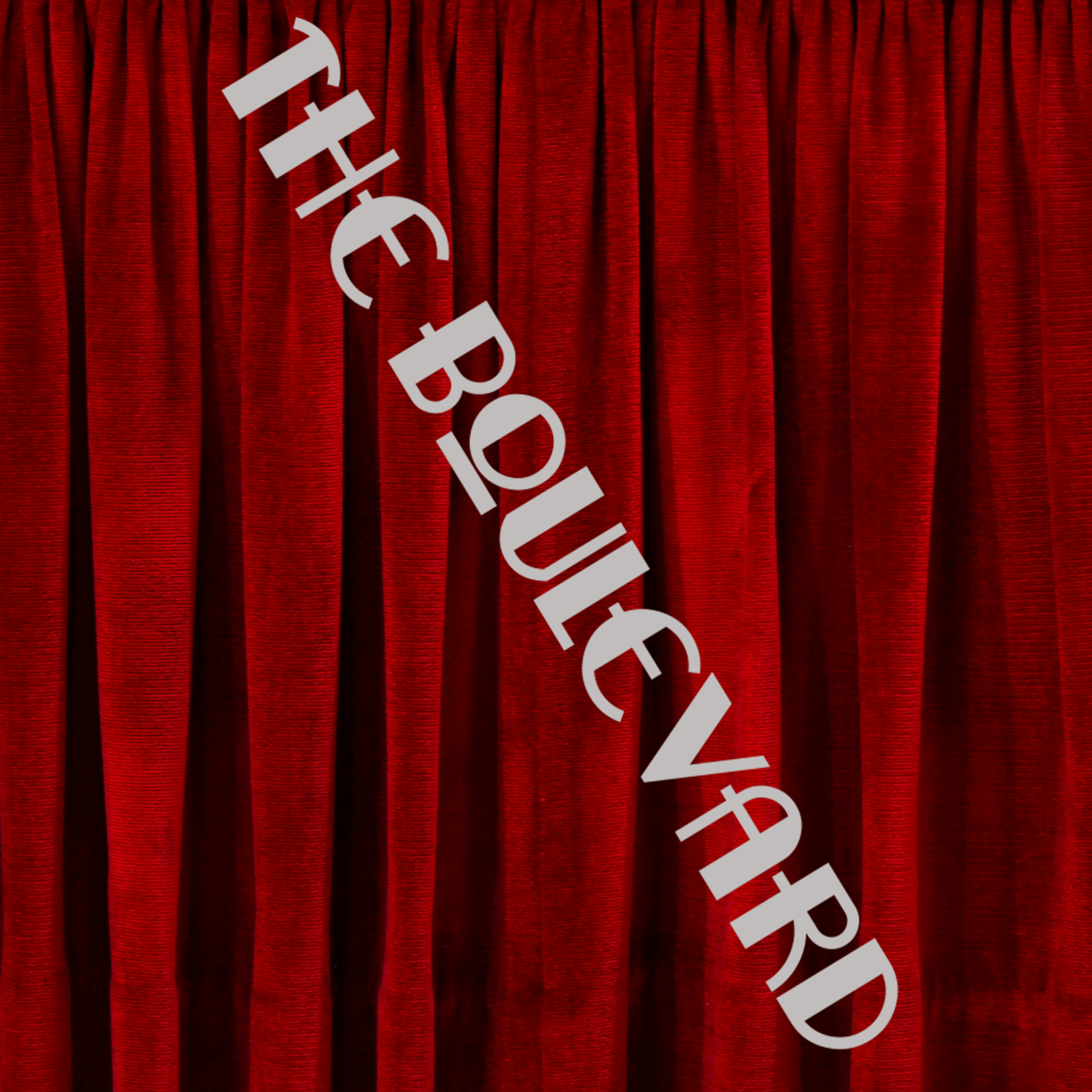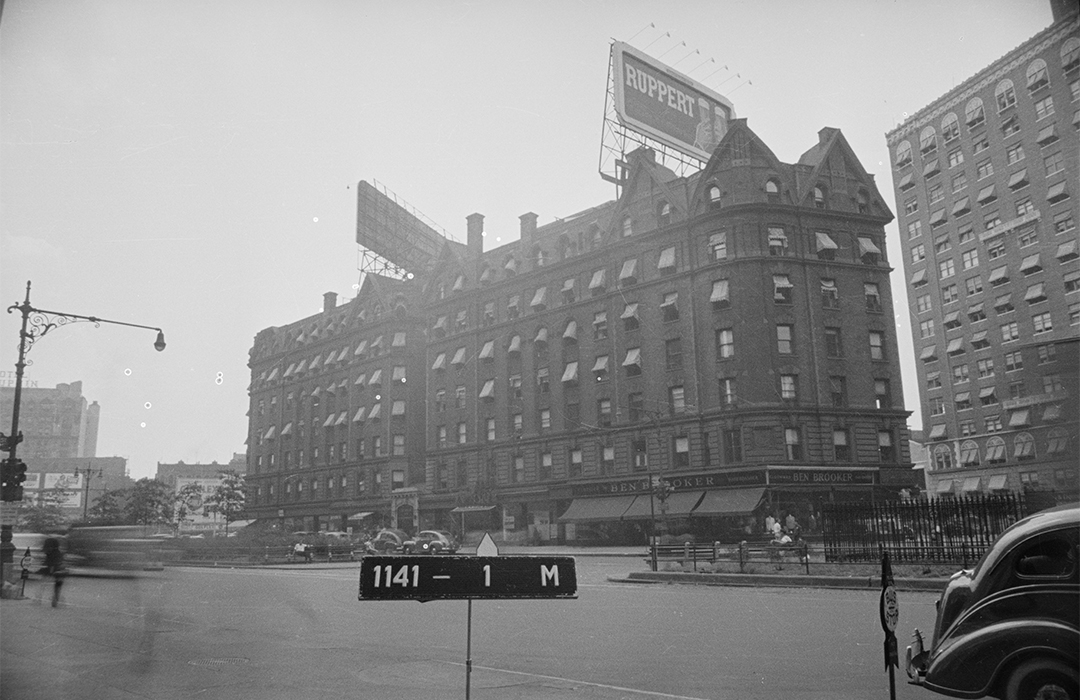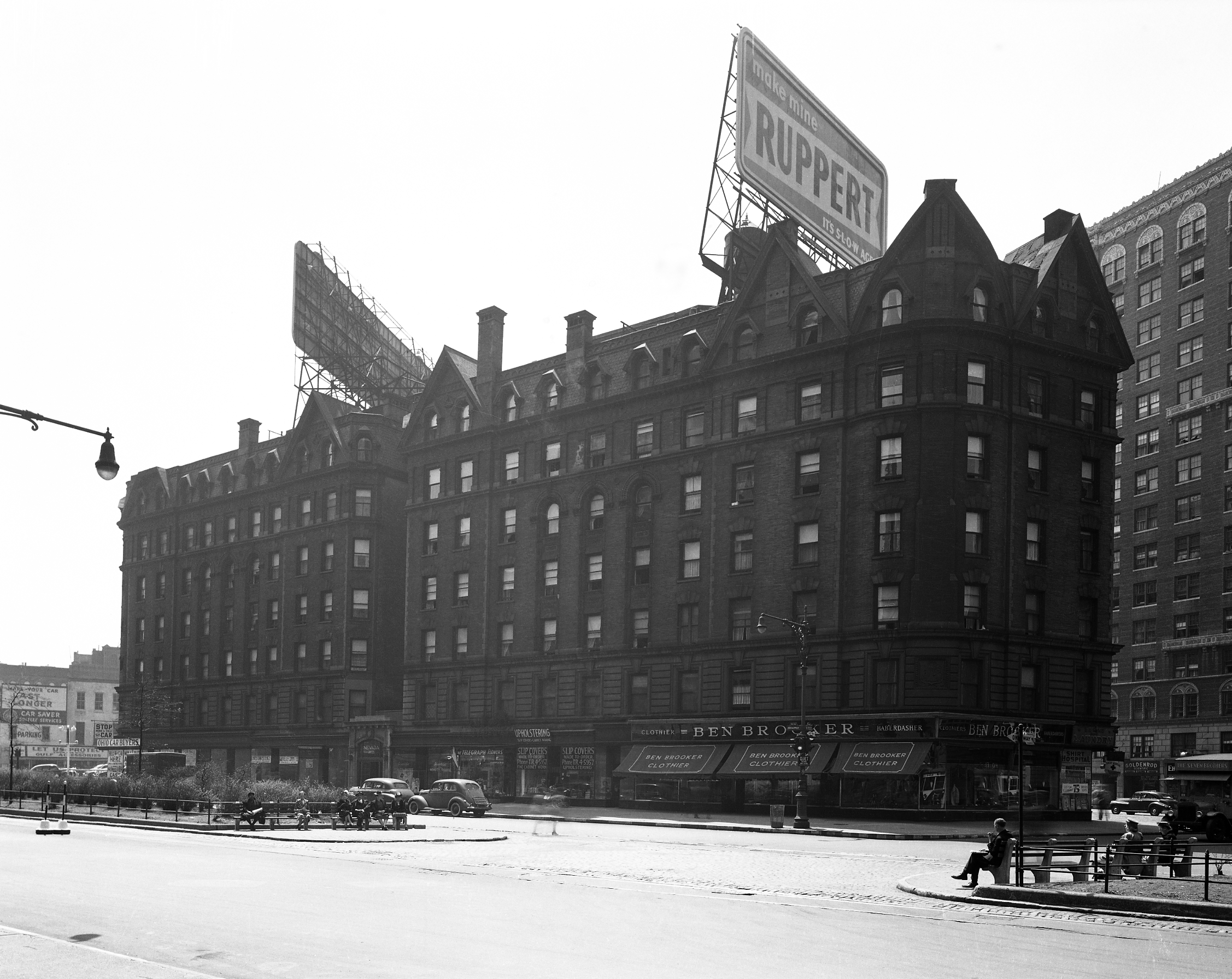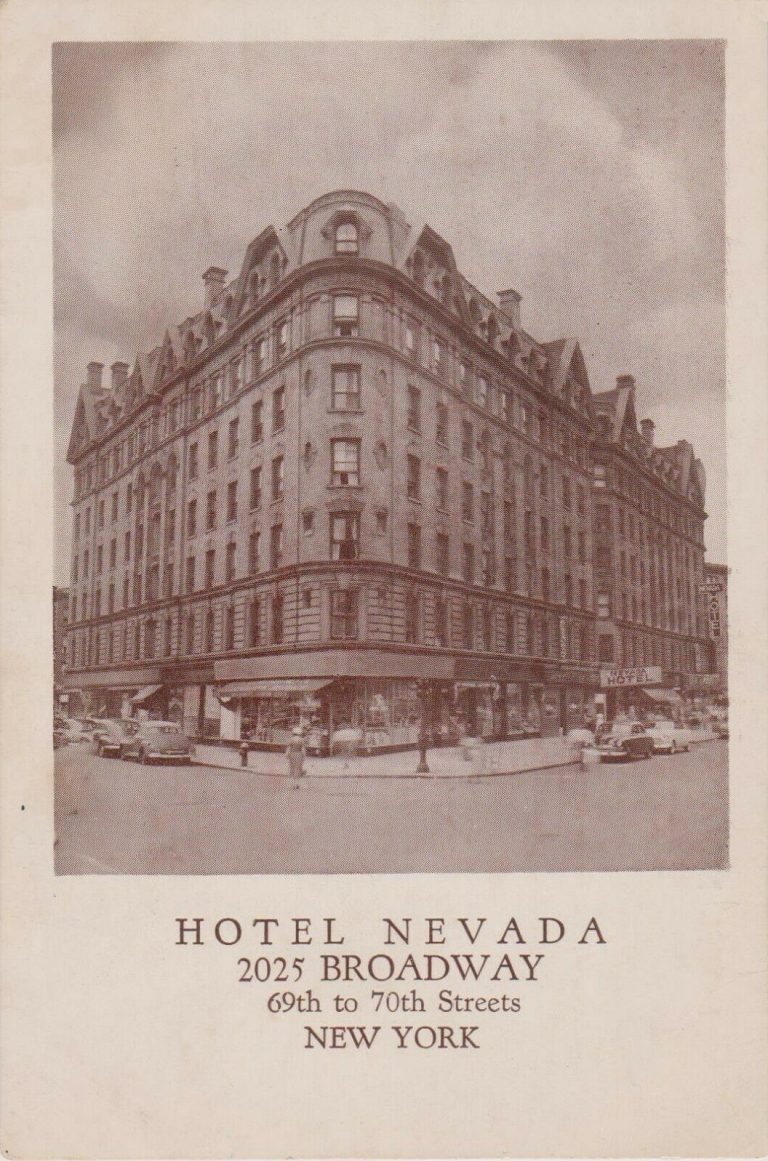
2025 Broadway, The Nevada
by Tom Miller
In 1891, real estate developers Terence Farley’s Sons teamed with J. F. Douthill to erect an apartment hotel on the triangular-shaped plot between 69th and 70th Streets and The Boulevard (later Broadway) and Amsterdam Avenue. Designed by Lafayette Goldstone, the seven-story building was faced in brick and stone. Goldstone gently rounded the 69th Street corner. The top floor took the form of a slate-shingled mansard with myriad dormers and gables. Like the luxurious Dakota apartments, opened seven years earlier, it was given a Western name: the Nevada.
An advertisement in The New York Times on September 28, 1891, announced, “Apartments are now ready in Nevada.” Saying it occupied “the entire block bounded by the Western Boulevard, 69th St., Amsterdam Av., and 70th St.,” the ad boasted it was “The most perfect building in New-York for light and ventilation, and convenient to all west side car lines and to “L” stations.” Each of the apartments had eight rooms and a bath. The up-to-the-minute amenities included electric light and steam heat. The advertisement noted, “Dining room in connection with the building.”
Among the earliest residents were artist Frank Gaynor and his widowed mother. The two had just returned to America after having lived in a castle in Italy while Frank studied art. While there in 1888, Gaynor looked for a model. The World explained, “a pretty girl was recommended to him. For three years, on and off, the pretty model posed for the young artist.” The model was Concetta Galloni.
The Gaynors had barely settled into their apartment in the Nevada when Concetta, along with her mother and sisters, arrived in New York and sued Frank Gaylor for $50,000 damages for breach of promise. (The staggering sum would translate to nearly $1.75 million in 2024.) On May 7, 1892, The World reported, “Mr. Gaynor consented yesterday to talk of the case, and received several newspaper men in his handsome rooms in the Nevada apartment house.”
Gaynor characterized the suit as blackmail. “I say truly that I believe the action is only to make me provide for the girl and her mother.” He said condescendingly, “Any artist knows that a model is a model, especially in Italy. And such a thing as a promise of marriage is absurd. I wrote to the girl, yes, who is a pretty model, but she is without family or education, and the absurdity of even contemplating such a thing as matrimony is too evident.” His mother was equally elitist. “It is simply an attempt to get money,” she said. “The effort is too transparent. The idea of my son promising to marry an ignorant Italian girl—a professional model. You may be sure that a very vigorous defense will be made.”
Adolph Georga walked into the Yorkville Police Court and asked for a warrant for the arrest of his mother-in-law.
The presumption that Gaynor had been intimate with Concetta Galloni was gently worded. The World said, “Taylor is of excellent family, good-looking and talented, and his defense will be supported by several artists, who claim to have knowledge of the fair plaintiff’s frailty.” (“Frailty” suggested Concetta’s inability to resist the sexual advances of men.)
Adolph Georga and his wife had a serious problem in the summer of 1897—Mrs. Georga’s mother, Anna Darling. The Georgas had been married 15 years, and earlier that summer, Mrs. Darling asked to move in. “I only want to stay a few days,” she said, according to The World. But once ensconced in the apartment, Anna Darling refused to leave. And she was constantly battling her daughter. Adolph Georga told a reporter, “She has more trouble with her own daughter, my wife, than with me…I’ve never had any trouble with my wife, but now she’s home crying.”
By August 2, 1897, the situation had become unbearable. That day Adolph Georga walked into the Yorkville Police Court and asked for a warrant for the arrest of his mother-in-law.
“What did she do?” asked Magistrate Wentworth.
“It would take much less time for me to tell you what she didn’t do. In a word, she has made my life miserable, and something has got to be done. Oh, she’s a terror without any holiness, and when she gets on a rampage, which is so often that it is almost continuous, she makes things more than lively for us and for our neighbors.”
Wentworth asked, “What does your wife say about this?
“Oh, she wants her out of the house just as much as I do. The old lady is a plague to both of us.”
The magistrate opined, “I suppose it is the usual case of too much mother-in-law,” and wrote out a summons. Georga took it to the West 68th Street stationhouse and asked for a policeman to accompany him back to his apartment and arrest Mary Darling for disorderly conduct.
It did not go well. When the policeman told Mrs. Darling she would have to leave, she answered, “Why certainly. Just show me your warrant.” When he tried diplomacy, she asserted, “that as she owned the furniture in the rooms she had a right to be there,” according to The Sun. The newspaper added, “The policeman concluded that she had reasoned correctly, and refused to make the arrest.” Adolph Georga got the warrant to which his mother-in-law had referred, and the following day, The World reported, “the case is likely to be heard in court to-day; that is, if he got a chance to serve it.”
A prominent resident was Dr. Isaac Newton Love. The Evening World described him as “known to the medical profession throughout the country as a physician of skill and learning.” He and his wife, the former Florence N. Williams, had two children, Hodgen and Delphine.
In May 1903, Dr. Love sailed to Europe, accompanying a patient, Mrs. George Law, who was still recovering from an appendicitis operation he had performed. He boarded the Cunard liner Aurania for his return voyage. As the ship steamed into the upper bay on its approach to Manhattan, the passengers decided that the trip had been so pleasant that “resolutions of commendation” should be presented to the officers and crew. Dr. Love was chosen to do the honors.
On June 18, The Evening World reported, “He had arisen from his seat to make this speech and stood smiling while his fellow passengers clapped their hands in applause. Before he could speak, he clapped his hands to his head and fell to the floor.” The ship’s surgeon, Dr. Billian, pronounced him dead “as soon as he touched him.” Dr. Love’s body was brought to his Nevada apartment, and his funeral was held at St. Paul’s Methodist Episcopal Church on West 86th Street on June 22.
The Nevada was renovated in 1911. Among the updates was the conversion of one room in each apartment into a servant’s room and bathroom. An advertisement on September 26 boasted, “Modernized in every detail, the Nevada Apartments are now the equal of any other high-class apartments in the city.” It said, “The rooms are large and excellently arranged, and their appointments are equal to those of a private residence. The dining and drawing rooms have large open fireplaces.” Rents ranged from $1,500 to $2,200—about $6,000 per month for the most expensive in today’s money.
Among the girls who worked for her was Mildred Gryscznski, who testified that she worked as a prostitute in Birdie’s Nevada apartment, seeing between 30 and 50 clients a day.
An interesting resident was Alma C. Arnold, who lived here in 1914. She was diplomatically called Woman’s Who’s Who of America as the “widow by law of C. D. Arnold.” The term gingerly stepped around the word “divorced.” Born in Hamburg, Germany, in 1871, she had been practicing “drugless healing” since 1903. She founded and was president of The Healtharium in Washington, D.C. Woman’s Who’s Who of America said, “As such [she] was attacked by the American Medical Association and won medical freedom for the District of Columbia in 1907.” Alma Arnold moved to New York in 1909. An avid suffragist, she held memberships in a remarkable range of associations, including the Woman’s Press Club, the National First Aid Association, the National Medical Freedom League, and the Anti-Vivisection League.
Two other female physicians living here were Dr. Susan T. D. Seed and her sister Dr. Elizabeth Brand. They shared an apartment with their unmarried sister, Katherine Condon. (Whether the doctors were divorced or widowed is unclear.) Neighbors in the Nevada were no doubt shocked when they read of Dr. Seed’s arrest for shoplifting on March 5, 1920. When arrested, she had used her maiden name, Susan Condon. Her sisters immediately went into damage control mode. The New York Herald reported they, “denied that Susan Condon and Dr. Seed were one and the same woman. They asserted that their sister had been struck by an automobile and was confined to her bed.”
But when Dr. Seed appeared in court on March 4, the newspaper said, “There was no denial of the identity.” Dr. Susan T. D. Seed pleaded guilty and paid a $100 fine. How she had expected to leave the James McCreery & Co. department store without being noticed is puzzling. The New York Herald reported, “The articles were two handbags, eight napkins and a bookrack.”
By the Depression years, the Nevada had significantly declined. In November 1935, Nicholas Montana was tried for running a place of prostitution known as “Birdie’s” since around 1933. In his opening remarks, the prosecutor said in part, “Birdie was the Madam of this house of prostitution.” Among the girls who worked for her was Mildred Gryscznski, who testified that she worked as a prostitute in Birdie’s Nevada apartment, seeing between 30 and 50 clients a day.
Things got worse for the once-refined apartment house in 1948, when it was converted into a single-room-occupancy hotel. In 1972, it appeared that salvation would come when speakers urged the City Planning Commission to allow “a community-based development corporation,” as described by The New York Times, to convert the Nevada into “housing for the elderly.”
But instead, the Nevada was demolished. In its place, builder Hyman Shapiro erected the 29-story Philip Birnbaum & Associates-designed Nevada Towers.
Tom Miller is a social historian and blogger at daytoninmanhattan.blogspot.com
BUILDING DATABASE
Keep Exploring
Be a part of history!
Think Local First to support the business at 2025 Broadway/201 Amsterdam Avenue:
Meet Dr. Dmitry Volfson
Meet Andrew Kaplan, DVM




